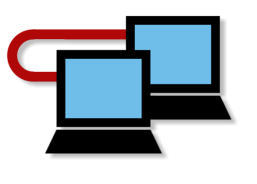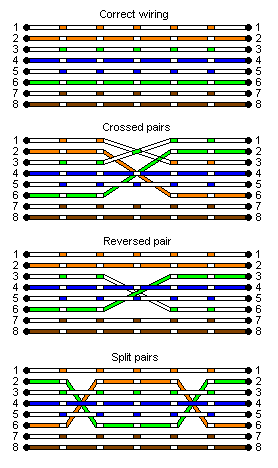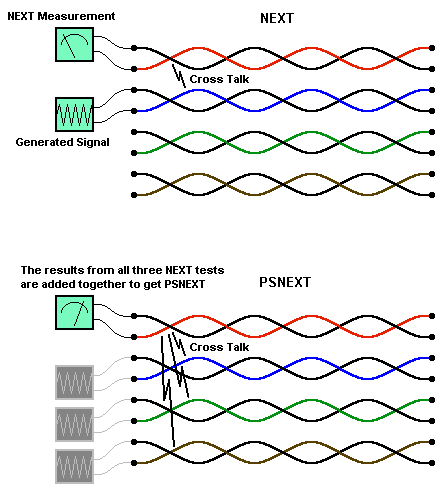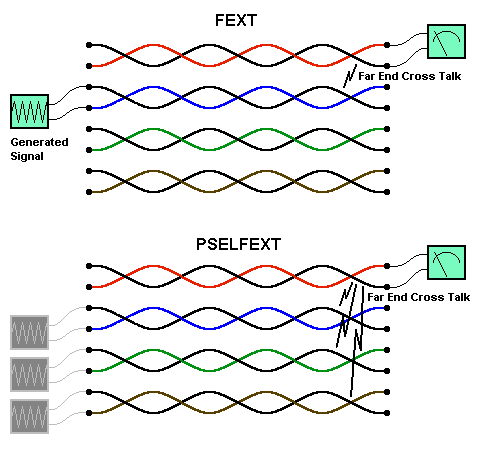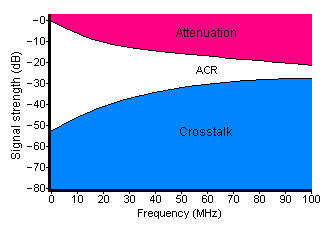
ACR
The first thing to understand about testing
understand about testing data cables is the ACR,
data cables is the ACR, this stands for Attenuation
this stands for Attenuation to Crosstalk Ratio. The
to Crosstalk Ratio. The pink area in the graph is
pink area in the graph is the attenuation, this can be
caused by several things
the attenuation, this can be
caused by several things as will be explained below,
as will be explained below, and the blue area is the
and the blue area is the crosstalk. Attenuation is the reduction in signal strength over the length of the
crosstalk. Attenuation is the reduction in signal strength over the length of the cable and frequency range, the crosstalk is the external noise that is introduced into the cable. So, if
cable and frequency range, the crosstalk is the external noise that is introduced into the cable. So, if the two areas meet, the data signal will be lost because the crosstalk noise will be at the same level as
the two areas meet, the data signal will be lost because the crosstalk noise will be at the same level as the attenuated signal.
ACR is the most important result when testing a link because it represents the overall performance of
the attenuated signal.
ACR is the most important result when testing a link because it represents the overall performance of the cable.
the cable.
So what causes the signal to attenuate?, and where does the crosstalk come from?
Below are of some of the terms used in high performance cable testing, and a description of what they mean.
mean.
Length
The length of a cable is one of the more obvious causes of attenuation because the longer it is, the more resistance it has, and therefore less of the signal will get through. To measure the length, a cable
more resistance it has, and therefore less of the signal will get through. To measure the length, a cable tester uses Time Domain Reflectometry (TDR). A pulse is sent down the cable and when it reaches the
tester uses Time Domain Reflectometry (TDR). A pulse is sent down the cable and when it reaches the far end it reflects back, by measuring the time it takes to travel down the cable and back again, the
far end it reflects back, by measuring the time it takes to travel down the cable and back again, the tester can determine how long the cable is. To do this, the tester also needs to know how fast the
tester can determine how long the cable is. To do this, the tester also needs to know how fast the pulsed signal is travelling, this is called the Nominal Velocity of Propagation (NVP) and is expressed as
pulsed signal is travelling, this is called the Nominal Velocity of Propagation (NVP) and is expressed as a percentage of the speed of light. The NVP is usually somewhere between 60% and 90% of the speed
a percentage of the speed of light. The NVP is usually somewhere between 60% and 90% of the speed of light, with most Cat 5E/6/6a/7/7a cables being around 70%. Due to the twists in the cable, the
of light, with most Cat 5E/6/6a/7/7a cables being around 70%. Due to the twists in the cable, the measured length will be greater than the physical length, so if a run looks like it might be over 80m it
measured length will be greater than the physical length, so if a run looks like it might be over 80m it would be wise to check it before it is tied up and terminated.
would be wise to check it before it is tied up and terminated.
Wire Map
This test is to ensure that the two ends have been terminated pin for pin, i.e. that pin 1 at the patch panel goes
to pin 1 at the outlet, pin 2 goes to pin 2 etc. etc. The wire
terminated pin for pin, i.e. that pin 1 at the patch panel goes
to pin 1 at the outlet, pin 2 goes to pin 2 etc. etc. The wire map also checks for continuity, shorts, crossed pairs,
map also checks for continuity, shorts, crossed pairs, reversed pairs and split pairs. A Split pair is probably the
reversed pairs and split pairs. A Split pair is probably the only thing that requires an explanation here, as they are
only thing that requires an explanation here, as they are undetectable with a simple continuity tester, this is because
undetectable with a simple continuity tester, this is because pin for pin they seem to be correct. As explained on the
pin for pin they seem to be correct. As explained on the Cabling Basics page, balanced line operation requires that
Cabling Basics page, balanced line operation requires that the signal is transmitted over a pair of wires that are twisted
the signal is transmitted over a pair of wires that are twisted together, with a 'split pair' the signal would be split between
together, with a 'split pair' the signal would be split between two different pairs.
two different pairs.
Return Loss
When a cable is manufactured there are slight imperfections in the copper. These imperfections all
imperfections in the copper. These imperfections all contribute to the Structural Return Loss (SRL)
contribute to the Structural Return Loss (SRL) measurement because each one causes an impedance
measurement because each one causes an impedance mismatch which adds to the cables attenuation.
mismatch which adds to the cables attenuation.
DC loop resistance
This is simply the resistance between the two conductors of a twisted pair which is looped back at the far end. The primary purpose of this test is to make sure that there are no high resistance connections
far end. The primary purpose of this test is to make sure that there are no high resistance connections in the link.
in the link.
Attenuation
This is the decrease in signal strength (expressed as negative dB) from one end of a cable to the other. The main causes of attenuation are impedance, temperature, skin effect and dielectric loss. Impedance is the combination of resistance, inductance and capacitance in a cable, it is measured in Ohms and
is the combination of resistance, inductance and capacitance in a cable, it is measured in Ohms and opposes the flow of current. Skin effect is phenomena which happens at high frequencies where the
opposes the flow of current. Skin effect is phenomena which happens at high frequencies where the signal tries to escape from the confines of the copper and into the air. The signal travels along the outer
'skin' of the copper which effectively reduces the cross sectional area of the cable and therefore
signal tries to escape from the confines of the copper and into the air. The signal travels along the outer
'skin' of the copper which effectively reduces the cross sectional area of the cable and therefore increases its resistance.
increases its resistance.
NEXT
This stands for Near End cross Talk, and it occurs because
Talk, and it occurs because alternating current flow
alternating current flow produces an electromagnetic
produces an electromagnetic field around the cable, this field
field around the cable, this field then induces a current flow in
then induces a current flow in adjacent cables. The strength of
this field increases with the
adjacent cables. The strength of
this field increases with the frequency of the signal, and
frequency of the signal, and because the speed of data
because the speed of data transmissions is ever
transmissions is ever increasing, NEXT is a big
increasing, NEXT is a big problem.
The name 'Cross Talk' comes
problem.
The name 'Cross Talk' comes from the telecommunications
from the telecommunications industry, you may have heard a
industry, you may have heard a faint conversation in the
faint conversation in the background while on the phone
background while on the phone yourself, this is caused by the
yourself, this is caused by the electromagnetic effect between
electromagnetic effect between adjacent telephone wires. In the
adjacent telephone wires. In the transmission of data, cross talk
transmission of data, cross talk is at its highest level in the RJ45 connection as it enters the cable, or at the 'Near End'. The term 'Near
is at its highest level in the RJ45 connection as it enters the cable, or at the 'Near End'. The term 'Near End' is slightly confusing because data can travel in both directions, and the NEXT test is carried out in
End' is slightly confusing because data can travel in both directions, and the NEXT test is carried out in both directions automatically by the tester, so the NEXT result is relative to the end of the cable that it
both directions automatically by the tester, so the NEXT result is relative to the end of the cable that it was carried out on.
The twists in a cable help to cancel out the effects of NEXT and the more twists there are, the better
was carried out on.
The twists in a cable help to cancel out the effects of NEXT and the more twists there are, the better the cancellation, however, the twists also increase attenuation, so there is a trade off between NEXT
the cancellation, however, the twists also increase attenuation, so there is a trade off between NEXT cancellation and attenuation. The twist rates in data cables are optimised for the best overall
cancellation and attenuation. The twist rates in data cables are optimised for the best overall performance, the twist rates are also varied for each pair within the cable to help combat crosstalk.
performance, the twist rates are also varied for each pair within the cable to help combat crosstalk.
PSNEXT
This stands for Power Sum Near End Cross Talk and is actually just a calculation. When a tester carries out the NEXT test it measures the cross talk on each pair as affected by each of the other three
carries out the NEXT test it measures the cross talk on each pair as affected by each of the other three pairs individually, PSNEXT is simply the addition of the three NEXT results for each pair. So this is the
pairs individually, PSNEXT is simply the addition of the three NEXT results for each pair. So this is the combined effect that a pair would be subject to when used in a network that supports a four pair
combined effect that a pair would be subject to when used in a network that supports a four pair transmissions method, e.g.. Gigabit Ethernet.
transmissions method, e.g.. Gigabit Ethernet.
FEXT, ELFEXT and
PSELFEXT
Basically, Far End Cross Talk (FEXT) is like NEXT
Talk (FEXT) is like NEXT but it is measured at the
but it is measured at the far end (well that seems
far end (well that seems logical!). However, on its
logical!). However, on its own FEXT doesn't mean
own FEXT doesn't mean much because the length
much because the length of the cable determines
of the cable determines how much the signal is
how much the signal is attenuated before it can
attenuated before it can affect the pairs at the far
affect the pairs at the far end. To compensate for
end. To compensate for this, and to provide a more
this, and to provide a more meaningful result, the
meaningful result, the attenuation is subtracted
attenuation is subtracted from the FEXT test and the
from the FEXT test and the result is then called Equal
result is then called Equal Level Far End Cross Talk
Level Far End Cross Talk (ELFEXT).
(ELFEXT). And of course, no test
And of course, no test parameter these days would be complete without adding the results together for each pair and calling it
parameter these days would be complete without adding the results together for each pair and calling it a Power Sum measurement, so now we have Power Sum Equal Level Far End Cross Talk or
a Power Sum measurement, so now we have Power Sum Equal Level Far End Cross Talk or PSELFEXT for short. There is now a new term for ELFEXT which is "Attenuation to Crosstalk Ratio,
PSELFEXT for short. There is now a new term for ELFEXT which is "Attenuation to Crosstalk Ratio, Far-end" (or ACRF).
Far-end" (or ACRF).
Delay
This is the propagation delay or the time it takes for the signal to travel from one end of the cable to the other, it is not very important on it own because its value is directly proportional to the length of the cable. What is important is the relationship between the delays on each of the four pairs. This brings us
nicely on to .........................
cable. What is important is the relationship between the delays on each of the four pairs. This brings us
nicely on to .........................
Delay Skew
Now this is important, Delay Skew is the difference between the fastest and slowest pairs. Some
between the fastest and slowest pairs. Some networks use a four pair transmission method, this
networks use a four pair transmission method, this means that the signal is split into four, sent down the
means that the signal is split into four, sent down the four pairs in the cable and re-combined at the far
four pairs in the cable and re-combined at the far end. It is essential that the signals reach the far end
end. It is essential that the signals reach the far end at near enough the same time, otherwise the signal
at near enough the same time, otherwise the signal will not be re-combined correctly.
will not be re-combined correctly.









Network Cabling Help - Copyright © 2016 - All rights reserved. - Privacy and Cookie Policy
